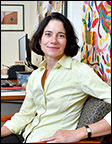 Professor Barbara E. Mundy is Chair and Professor of Art History at Fordham University in New York. She specialises in Latin American art with an emphasis on indigenous art and cartography in the 16th century.
Professor Barbara E. Mundy is Chair and Professor of Art History at Fordham University in New York. She specialises in Latin American art with an emphasis on indigenous art and cartography in the 16th century.
Her first book, The Mapping of New Spain: Indigenous Cartography and the Maps of the Relaciones Geográficas (1996) was winner of the 1996 Nebenzahl Prize in the History of Cartography.
In 2012, she co-edited a volume with Mary E. Miller, Painting a Map of Sixteenth-Century Mexico City: Land, Writing and Native Rule (Yale/Beinecke Library, 2012), which sheds light on a rare map of Mexico City, and includes the most extensive scientific analysis of any New World manuscript to date.
Her latest book, The Death of Aztec Tenochtitlan, the Life of Mexico City (2015), centres on Tenochtitlan-Mexico City and its transformation from the sacred capital of the Aztecs into the centre of Spain’s overseas empire. It was winner of the 2015 Arvey Award from the Association of Latin American Art for the year’s best book on Latin American art history, and received the Latin American Studies Association Book Award (Colonial section). It received the 2017 Bryce Wood Book Award from the Latin American Studies Association.
Professor Mundy’s interest in digital humanities has resulted in a pioneering work, Vistas: Visual Culture in Spanish America, 1520-1820, that was co-authored with Dana Leibsohn and funded by an N.E.H. digital development and demonstration grant. The project is accessible online www.fordham.edu/vistas.
In episode 12 of History Hub’s podcast series – ‘Kingdom, Empire and Plus Ultra: conversations on the history of Portugal and Spain, 1415-1898‘ – Professor Mundy is in conversation with series host Dr Edward Collins. In the episode, which is available to podcast on iTunes and Soundcloud, they discuss the overthrow of the great Aztec city of Tenochtitlan in 1521.
To Spanish conquerors, this city, built on Lake Texcoco in the Valley of Mexico, was unlike anything they had ever seen when they first encountered it in 1519. Yet, just two years later, the Aztec capital had fallen to Spanish forces and was in ruins, and its leaders dead or imprisoned. But did the city really die? Was it buried and reimagined as the new Spanish colonial city of Mexico?
‘Tenochtitlan: Transformation & Endurance after the Spanish Conquest’ with Professor Barbara E. Mundy (Fordham University).
View accompanying slides of relevant images and maps
Kingdom, Empire and Plus Ultra
This History Hub podcast series features interviews with experts in the areas of Portuguese and Spanish history, from the beginning of the Portuguese discoveries in 1415 to the end of Spanish dominion in America in 1898. The interviews, conducted by historian Dr. Edward Collins, cover a range of topics on the domestic and overseas histories of both nations, which include, among others: the Portuguese explorations of Africa and Asia, Spanish navigation and settlement in America, the church in Portugal and Spain, monarchy and intermarriage in the Iberian kingdoms, natural science and mapping in America, the role of nautical science, Irish historical relations with Portugal and Spain, and imperial competition in Europe and overseas. The interviewees comprise a number of established and renowned academics, as well as up-and-coming researchers from universities and institutions worldwide.
This History Hub series is funded by UCD Seed Funding and supported by UCD School of History. Series editor is Mike Liffey (Real Smart Media).
Download series episodes on iTunes or listen via Soundcloud.
Episodes
- Series introduction by Edward Collins
- Episode 1: Portugal and Spain in the 15th and early-16th centuries: a brief overview by Edward Collins
- Episode 2: Ellen Dooley on the Spanish Inquisition and the religious image in Spain & America, 1478–1700
- Episode 3: Ricardo Padrón on America, the Pacific, and Asia in the Imperial Imagination, 1513-1609
- Episode 4: Allison Bigelow on the Science of Colonial Silver: Rethinking the History of Mining and Metallurgy in the Early Americas
- Episode 5: Early Colonial Brazil, English Piracy, and the Adventures of Anthony Knivet (1591-1599) by Vivien Kogut Lessa de Sá
- Episode 6: Onésimo T. Almeida on Portugal and the Dawn of Modernity, 1419-1620
- Episode 7: Jorge Cañizares-Esguerra on Old Testament Culture in the Spanish Monarchy in the Sixteenth and Seventeenth centuries
- Episode 8: Zoltan Biedermann on ‘A Negotiating Empire: Portuguese diplomacy in Asia and the Global Renaissance’
- Episode 9: Flora Cassen on ‘Philip II and His Italian Jewish Spy’.
- Episode 10: Tamar Herzog on ‘Frontiers of Possession: Spain and Portugal in Europe and the Americas’.
- Episode 11: Pedro Cardim on ‘The Idea of Hispania: Portugal and the Spanish Monarchy in the 16th and 17th Centuries’
- Episode 12: Barbara E. Mundy on ‘Tenochtitlan: Transformation and Endurance after the Spanish Conquest’
Image: detail from Folio 2r of the Codex Mendoza, a mid-16th century Aztec codex. Depicts the founding of Tenochtitlan, and the conquest of Colhuacan and Tenayucan. [Public domain], via Wikimedia Commons.

